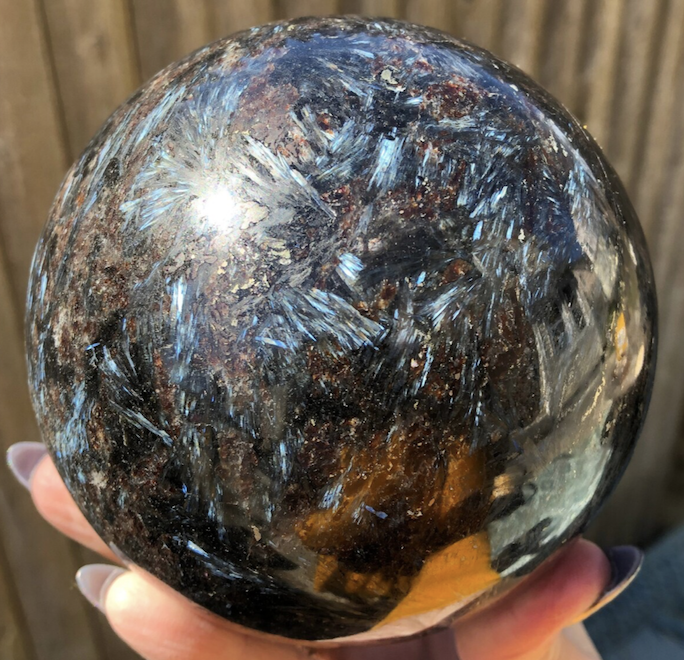
Arfvedsonite or Astrophyllite? Neither!
I’ve seen this same stone popping up at trade shows and supplier warehouses for years now, with several different names. Many suppliers call it “Fireworks Stone,” I see lots of it online sold as “Astrophyllite” or “Arfvedsonite.” I’ve seen lots of metaphysical sites comparing the two and proclaiming them to be one or the other. I have spent a long time trying to figure it out and in the past have settled for calling it Arfvedsonite just because I have to call it something. But there are many inconsistencies with those labels when it comes to the stone in question.
First the easiest one - “Fireworks Stone” is not a name of any mineral accepted by any reputable mineral or gem organization. It doesn’t mean anything and doesn’t tell us anything about what it actually is or the minerals in it. We call this a marketing or trade name - someone made it up to sell more rocks because it sounded cool or they didn’t actually know what kind of stone it was- or both.
Next, Astrophyllite. It forms gold, iridescent sprays much like the ones seen in the material in question. However, according to Mindat its color is “bronze-yellow, golden yellow, brown to reddish brown.” The stones that I have seen of the mystery material often have more blue than gold and yellow. Sometimes they are more gold too, but it cannot be Astrophyllite when so much of this material is so very blue. Astrophyllite also occurs more in radial “sun” shapes which often form full circles. Our mystery stone forms more often in “brush” shapes like a paintbrush pressed against a surface.
The third contender is Arfvedsonite. This is what I most commonly see this stone called online. If you post it in a mineral ID group, there will always be someone (never one of the geologists or mineralogists) who jumps to argue that it is Arfvedsonite. Mindat says the color of Arfvedsonite is “bluish-black to black” and in their gallery of 225 photos of Arfvedsonite specimens, all of them look closer to a Black Tourmaline than the material we are trying to identify. Every photo from a reputable source appears much like this photo - very dark or black crystals. Nothing iridescent gold or blue at all.
Finally after many hours spread over several years down this rabbit hole I believe I have found the answer. The name of the mineral in question is Anthophyllite. Anthophyllite is a fibrous amphibole mineral. It is also iridescent but can have gold, yellow, green, blue, and brown - so the iridescence of Anthophyllite fits much better than either of the other minerals it is often called.
On Mindat, there is a photo in the gallery for Anthophyllite that very much resembles the mystery material. It is labeled “Anthophyllite, Garnet, Cordierite.” The piece that I currently have does appear to have a lot of sparkly Almandine Garnet, which makes it a much more believable identification than other minerals. I have often seen the red part of this material called Eudialyte, but none of the aforementioned minerals appear to occur much in association with Eudialyte. My guess is that someone assumed it to be Eudialyte because that is a red mineral associated with Astrophyllite. Anthophyllite, on the other hand has both Garnet and Cordierite listed under common associates.
Another mineral listed under Anthophyllite’s common associates is Gedrite. This is interesting because Gedrite looks pretty similar to Anthophyllite, occurring in fibrous sprays, but is mostly black or dark green. The photo on the left here is Gedrite with Garnet. In the material I have now, shown on the right, there is a lot of shiny black sprays that are around the golden ones, and Anthophyllite and Gedrite do indeed occur together. Random fun fact- Gedrite and Anthophyllite alone together have a trade name you’ve probably heard before - Nuummite!
I found an article on Epigem that talks about this stone pictured, found in Sweden and described as an Anthophyllite schist “with reddish brown garnet, granular epidote and colorless cordierite.” This makes so much sense because so many of the pieces of this material I’ve had also had bits of green in them, and the one I’m looking at now does have some areas of clear stone that appears to sparkle similar to other cordierites I have had. In comparison, Cordierite does not often occur with Arfvedsonite, which mostly forms on Feldspars. It is also not listed as an associated mineral of Astrophyllite. So again, it seems that Anthophyllite is the most likely identification of these no-longer mysterious iridescent blue and gold sprays.
Andara Crystals: Trash or Treasure?
Maybe you’ve heard of Andara Crystals before. They’ve become popular in the metaphysical realm of crystals the last few years. According to one popular seller they are natural glass which “come from one of the Earth’s high-energy vortex sites in the High Sierra Nevadas of northern California, Lady Nellies Land.” There are a vast range of claims about Andara glass and the amazing things they can do.
One is that it contains something called “entherium,” containing 70 different minerals. This is complete nonsense. Entherium is completely made up and these pieces of glass do not have 70 minerals in them.
They also claim to be Monatomic - which means of one atom. Doesn’t make any sense in this s scenario.
I have read claims that Andara glass can aid in time and space travel, raise our vibrations, detox negativity, heal you, cleanse the chakras and it seems that there’s nothing these people WON’T say it can do! And they have price tags to match, with small pieces going for hundreds or thousands of dollars.
Sorry folks but Andara glass, regardless of what the seller says, is slag glass. It is the garbage found at an old abandoned dumping ground of a glass factory. Several “healers” buy the slag glass and distribute it to each other, making up names and creating “certifications” for each other. It’s ALL a scam. People are paying thousands of dollars for beautiful, lovely garbage. And hey- they are pretty! But you can buy the same exact thing for almost nothing from honest slag glass sellers.
There is a thread about the Andara scam on Mindat (one of the most reputable sites and forums for those who are truly interested in learning about minerals - frequented by many true experts of mineralogy and geology!) and one entry is a woman that says she is the only one who has a certain color of the glass, called “King Solomon,” and found out one of her buyers was reselling her glass as Andara glass. The woman expressed that she was very angry that her material was being used to scam others. In the thread, they even name some of the people responsible for the whole scam.
It just so happens that ‘new’ color variations of Andara glass happen to be ‘found’ at the same times that glass companies start dumping those same new colors. Huh. I can see how one could easily believe in the story of Andara glass, because Obsidian exists, but with a bit of research the evidence stacks up ridiculously tall against it being anything but an elaborate scam. I hope that this can save someone from wasting a lot of their hard earned money on a piece of slag glass they could get elsewhere for a few bucks.
What other fakes, frauds or scams have you heard of??
Please comment below!
-Shawna


















